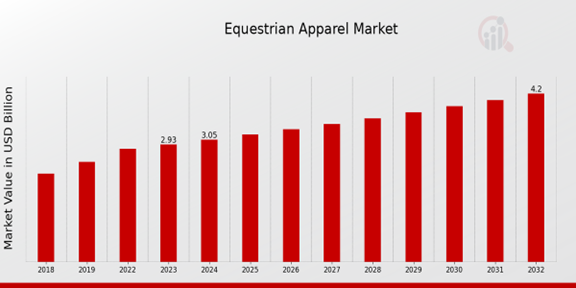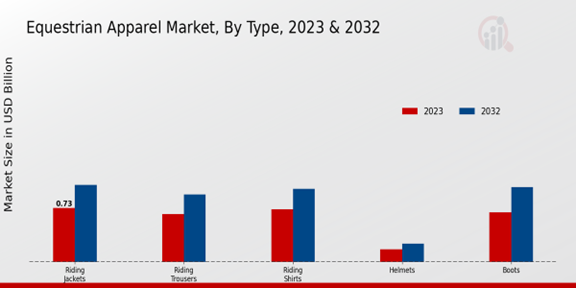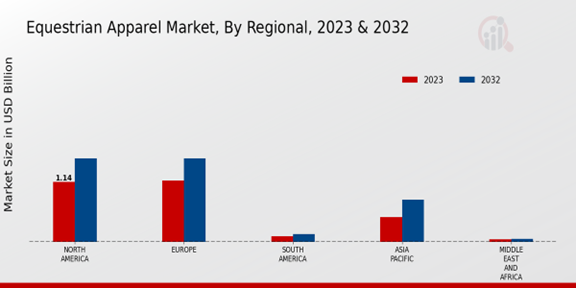Global Equestrian Apparel Market Overview
The Equestrian Apparel Market Size was estimated at 3.18(USD Billion) in 2024. The Equestrian Apparel Market Industry is expected to grow from 3.31(USD Billion) in 2025 to 4.74(USD Billion) by 2034. The Equestrian Apparel Market CAGR (growth rate) is expected to be around 4.10% during the forecast period (2025 - 2034).
Key Equestrian Apparel Market Trends Highlighted
The equestrian apparel market is experiencing a surge in demand, driven by the growing popularity of equestrian sports, increasing disposable income, and rising awareness of fashion and functionality. Technological advancements are also playing a significant role, with the introduction of performance-enhancing materials and innovative designs. The growing emphasis on sustainability and eco-friendly practices is also shaping the market, with brands focusing on producing sustainable apparel options.
Key market drivers include the increasing participation in equestrian events and competitions, the growing number of horse owners, and the rising popularity of equestrian as a recreational activity. Opportunities to be explored lie in the expansion of e-commerce platforms, the development of innovative materials and technologies, and the customization of apparel to meet specific rider preferences.
Recent trends in the equestrian apparel market include the growing demand for personalized and customizable apparel, the rise of athleisure wear that combines comfort and functionality, and the increasing focus on ethical and sustainable practices. The market is also witnessing the emergence of new brands and designers who are bringing fresh perspectives and innovative designs to equestrian apparel.

Source: Primary Research, Secondary Research, MRFR Database and Analyst Review
Equestrian Apparel Market Drivers
Rising Popularity of Equestrian Sports
In recent years, equestrian sports have become increasingly popular, attracting a vast number of participants and onlookers from all over the world. The increased interest in the sport has concurrently driven interest in specialized riding attire, such as boots, riding helmets, breeches, and competition apparel. As more and more people continue to engage in equestrian sports, the demand for high-quality, performance-oriented equestrian attire has also surged, thereby boosting the demand for such products across the globe.There are several reasons for the surge of interest in the sport. One key factor is the increase in awareness about the health benefits associated with the activity. Equestrian activities present an opportunity to engage in physical exercises while also enjoying other benefits, such as mental stimulus and socialization. As such, it serves as a multifaceted activity that appeals to a vast array of people. The simultaneous increase in purchasing power in various regions of the world has also enabled more people to partake in equestrian sports.The growing social awareness about the sport and the wide variety of benefits associated with it have created a surge in interest and demand for quality riding products. Another significant factor for the surge in interest is the growing number of equestrian sporting events that are being held all around the world. Riders are constantly provided with opportunities to compete and demonstrate their skills in the sport. Media coverage has also shone a spotlight on the sport and its participants, making it more accessible to novices.
Technological Advancements in Equestrian Apparel
In the recent past, the equestrian apparel industry has witnessed significant technological advancements, providing innovative and high-performance products. Today, manufacturers implement advanced materials and technologies in apparel to offer comfort, safety, and functionality to riders. For instance, there have been advancements in the use of garments that do not only wick moisture but also breath, improving breathability, and letting riders regulate their body temperatures at extreme riding sessions.Such fabrics offer comfort and ensure riders are dry and comfortable even at extreme exercises. The use of lighter and more robust clothing materials has seen the development of protective features while keeping riders freer in movement. Moreover, technological advancements have also engineered specialized equestrian apparel for different riding disciplines, such as dressage, show-jumping, and eventing. These discipline-specific garments offer increased performance and requisite protection to riders.
Growing Awareness of Sustainability in the Equestrian Industry
The equestrian industry is increasingly acknowledging the significance of sustainable practices, which can be observed from the vivid demand for sustainable equestrian apparel. Thus, customers are becoming more conscious of the environmental effects of their purchases. They tend to purchase only those items that are produced from environmentally friendly materials and are processed according to sustainable approaches. In response, manufacturers utilize these perspectives while producing equestrian apparel.As a result, manufacturers use more recycled products and generate less waste; moreover, they use environmentally friendly technologies. Another trend is using natural and organic materials in equestrian apparel, such as bamboo, hemp, and organic cotton.
Equestrian Apparel Market Segment Insights
Equestrian Apparel Market Type Insights
The Equestrian Apparel Market is segmented by Type into Riding Jackets, Riding Trousers, Riding Shirts, Helmets, and Boots. The riding Jackets segment is expected to hold the largest market share in 2023 and is estimated to be valued at USD 1.2 billion in 2024, owing to the increasing popularity of equestrian sports and the growing demand for protective and comfortable riding gear. Riding Trousers segment is projected to witness the highest CAGR of 5.2% during the forecast period, driven by the rising adoption of riding breeches and jodhpurs specifically designed for equestrian activities.The riding Shirts segment is anticipated to account for a significant market share, supported by the growing demand for moisture-wicking and breathable fabrics in equestrian apparel. The helmet segment is expected to gain traction due to the increasing awareness about safety regulations and the mandatory use of helmets in equestrian competitions. The boots segment is projected to hold a steady market share, driven by the demand for durable and supportive footwear designed for riding.

Source: Primary Research, Secondary Research, MRFR Database and Analyst Review
Equestrian Apparel Market Product Category Insights
The Equestrian Apparel Market segmentation by product category into competition apparel, casual apparel, and protective gear offers valuable insights into the industry's dynamics. Competition apparel designed for professional equestrian competitions accounts for a significant share of the market due to its specialized features and high demand among riders. Casual apparel, including riding breeches, shirts, and base layers, caters to the everyday needs of horse enthusiasts and is expected to witness steady growth as participation in equestrian activities increases.Protective gear, consisting of helmets, body protectors, and gloves, plays a crucial role in ensuring rider safety and is projected to gain traction as safety regulations become more stringent. Overall, the product category segmentation of the Equestrian Apparel Market provides a comprehensive understanding of the market's offerings and their respective contributions to the industry's growth.
Equestrian Apparel Market Discipline Insights
The Discipline segment of the Equestrian Apparel Market encompasses various equestrian disciplines, including Dressage, Show Jumping, Eventing, Western, and Endurance. Each discipline has its unique requirements for riding attire, with specialized designs and materials to enhance performance and safety. Dressage, a discipline focused on precision and elegance, demands apparel that allows for a close connection between horse and rider. Show Jumping, involving obstacles and jumps, necessitates protective gear and breathable fabrics. Eventing, a three-phase competition, requires versatile apparel suitable for multiple disciplines.Western riding, rooted in working with cattle, emphasizes durable and functional attire. Endurance riding, testing horse and rider stamina over long distances, demands moisture-wicking and supportive gear. The Equestrian Apparel Market revenue is expected to reach $3.2 billion by 2024, with the Discipline segment playing a significant role. Market segmentation by discipline provides insights into the specific needs and preferences of riders within each discipline, enabling manufacturers to cater to their unique requirements and drive market growth.
Equestrian Apparel Market Gender Insights
The Equestrian Apparel Market is segmented into men, women, and children based on gender. The men's segment held the largest market share in 2023 and is projected to continue its dominance throughout the forecast period. This is due to the increasing popularity of equestrian sports among men, as well as the growing awareness of the importance of proper riding attire. The women's segment is also expected to witness significant growth, owing to the rising number of women participating in equestrian activities. The children's segment is expected to grow at a steady pace, driven by the increasing popularity of equestrian sports among children and the growing disposable income of parents.
Equestrian Apparel Market Regional Insights
The regional segmentation of the Equestrian Apparel Market offers valuable insights into the market's geographical distribution and growth dynamics. North America is anticipated to hold a dominant share of the market in 2023, accounting for approximately 35%. This dominance is attributed to the region's well-established equestrian industry, significant equestrian participation rates, and high disposable income levels. Europe follows closely behind, capturing around 30% of the market share. The region boasts a rich equestrian heritage, with numerous equestrian events and competitions taking place throughout the year.APAC is projected to exhibit the fastest growth rate over the forecast period, primarily driven by the rising popularity of equestrian sports in countries like China and India. South America and MEA are also expected to contribute to the overall market growth, albeit at a slower pace.

Source: Primary Research, Secondary Research, MRFR Database and Analyst Review
Equestrian Apparel Market Key Players And Competitive Insights
Major players in the Equestrian Apparel Market industry are constantly striving to gain a competitive advantage by introducing innovative products, expanding their distribution channels, and acquiring smaller players. The leading Equestrian Apparel Market players are focusing on developing high-quality products that meet the specific needs of equestrians. They are also investing in research and development to create new materials and technologies that will improve the performance and comfort of their products. In addition, the leading players are expanding their distribution channels to reach a wider range of customers. They are opening new stores in key markets and partnering with online retailers.One of the leading Equestrian Apparel Market companies is Ariat International. The company was founded in 1993 and is headquartered in Union City, California. Ariat designs, develops, manufactures, and markets a wide range of equestrian apparel, footwear, and accessories. The company's products are sold in over 70 countries around the world. Ariat is known for its high-quality products and its commitment to innovation. The company has a strong research and development team that is constantly developing new materials and technologies to improve the performance and comfort of its products. Ariat is also a major sponsor of equestrian events and athletes.Another leading Equestrian Apparel Market company is Charles Owen & Co. The company was founded in 1911 and is headquartered in Wrexham, Wales. Charles Owen designs, develops, and manufactures a wide range of equestrian helmets and other protective gear. The company's products are sold in over 50 countries around the world. Charles Owen is known for its high-quality products and its commitment to safety. The company has a strong research and development team that is constantly developing new technologies to improve the safety of its products. Charles Owen is also a major sponsor of equestrian events and athletes.
Key Companies in the Equestrian Apparel Market Include
- USG Equestrian
- Pikeur
- Horze Equestrian
- TuffRider
- Kerrits
- Ariat International
- GPA Helmets
- HV Polo
- Horseware Ireland
- Dublin Saddlery
- Equestrian Stockholm
- Samshield
- KEP Italia
- Animo Italia
- Charles Owen
Equestrian Apparel Market Industry Developments
In 2023, the market was valued at USD 2.93 billion.Key factors driving market growth include rising participation in equestrian sports, increasing disposable income, and growing awareness of equestrian fashion. The market is also benefiting from technological advancements, such as the development of moisture-wicking and antimicrobial fabrics.Recent news developments include the launch of new equestrian apparel collections by major brands such as Ariat International and Charles Owen. Additionally, several equestrian events and competitions are being held across the globe, which is further boosting market growth. Key players in the market include Ariat International, Charles Owen, Pikeur, Samshield, and Horze.
Equestrian Apparel Market Segmentation Insights
Equestrian Apparel Market Type Outlook
- Riding Jackets
- Riding Trousers
- Riding Shirts
- Helmets
- Boots
Equestrian Apparel Market Product Category Outlook
- Competition Apparel
- Casual Apparel
- Protective Gear
Equestrian Apparel Market Discipline Outlook
- Dressage
- Show Jumping
- Eventing
- Western
- Endurance
Equestrian Apparel Market Gender Outlook
Equestrian Apparel Market Regional Outlook
- North America
- Europe
- South America
- Asia-Pacific
- Middle East and Africa
| Report Attribute/Metric |
Details |
| Market Size 2024 |
3.18(USD Billion) |
| Market Size 2025 |
3.31(USD Billion) |
| Market Size 2034 |
4.74(USD Billion) |
| Compound Annual Growth Rate (CAGR) |
4.10% (2025 - 2034) |
| Report Coverage |
Revenue Forecast, Competitive Landscape, Growth Factors, and Trends |
| Base Year |
2024 |
| Market Forecast Period |
2025 - 2034 |
| Historical Data |
2020 - 2024 |
| Market Forecast Units |
USD Billion |
| Key Companies Profiled |
USG Equestrian, Pikeur, Horze Equestrian, TuffRider, Kerrits, Ariat International, GPA Helmets, HV Polo, Horseware Ireland, Dublin Saddlery, Equestrian Stockholm, Samshield, KEP Italia, Animo Italia, Charles Owen |
| Segments Covered |
Type, Product Category, Discipline, Gender, Regional |
| Key Market Opportunities |
Sustainable and eco-friendly products Increased demand for personalized apparel Emerging markets with growing equestrian activities Technological advancements in fabric and design Subscription-based services for equestrian gear |
| Key Market Dynamics |
Evolving fashion trends increasing disposable income, rising popularity of equestrian sports |
| Countries Covered |
North America, Europe, APAC, South America, MEA |
Frequently Asked Questions (FAQ) :
The equestrian apparel market is expected to reach USD 4.74 billion by 2034, growing at a CAGR of 4.10% from 2025 to 2034.
North America currently dominates the equestrian apparel market, followed by Europe and Asia-Pacific. Emerging markets such as Latin America and the Middle East are expected to witness significant growth in the coming years.
Equestrian apparel is primarily used for horse riding and equestrian sports. It includes a wide range of clothing and accessories, such as riding helmets, gloves, breeches, boots, and protective vests.
Prominent players in the equestrian apparel market include Ariat International, Charles Owen, Dover Saddlery, Equiline, Hks, KEP Italia, Pikeur, Samshield, and TuffRider.
Factors driving market growth include rising disposable income, increasing participation in equestrian sports, growing awareness of horse riding as a leisure activity, and the expansion of equestrian clubs and riding schools worldwide.
Challenges faced by the market include intense competition, fluctuating raw material prices, and changing fashion trends. Additionally, economic downturns and geopolitical uncertainties can impact consumer spending on equestrian apparel.
Opportunities for growth in the market include the development of innovative and sustainable equestrian apparel, expansion into emerging markets, and the growing popularity of online retail channels.
Key trends in the market include the integration of technology into equestrian apparel, such as smart riding helmets and GPS tracking devices. Additionally, there is a growing demand for customized and personalized equestrian apparel.
The equestrian apparel market is expected to register a CAGR of 4.10% from 2025 to 2034.
Key factors influencing market growth include rising disposable income, increasing participation in equestrian sports, and growing awareness of horse riding as a leisure activity.

















